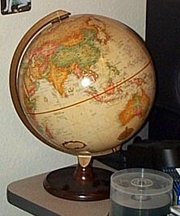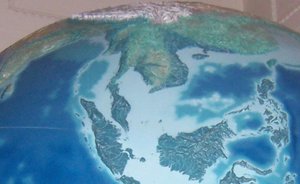Globe
|
|
A globe is a three-dimensional scale model of a spheroid celestial body such as a planet, star or moon, in particular Earth, or, alternatively, a spherical representation of the sky with the stars (not the Sun, Moon, or planets, because their positions vary relative to those of the stars; however, the "orbit" of the Sun is indicated).
Globes are the only geographical representation of Earth that has no distortion. Spheres such as the Earth are mapped onto a flat surface using a map projection with an inherent degree of distortion. These projections can either enforce angle preservation or area preservation. A typical scale for a globe is roughly 1:40 million.
The Earth is obviously the most popular planet represented but globes of the Sun, the Moon and other celestial objects have been made, including fictional ones.
The earliest globe, called the "Nürnberg Terrestrial Globe", was made during the years 1490-1492 by German mapmaker Martin Behaim.
A globe is usually mounted at an angle on bearings. In addition to making it easy to use this mounting also represents the angle of the planet in relation to its sun and the spin of the planet. This makes it easy to visualize how days and seasons change.
Sometimes a globe has relief, showing topography; in the case of a globe of the Earth the elevations are exaggerated, otherwise they would be hardly visible.
Mass-produced globes are typically covered by a printed paper map. The most common type has long, thin strips that touch at the equator, and narrow to a point at the north pole and the south pole. [1] (http://netpbm.sourceforge.net/doc/globe.jpg) Then a small disk is used to paper over the inevitable irregularities at the poles. The more strips there are, the less stretching and crumpling is required to make the paper map fit the sphere. From a geometric point of view, all points on a sphere are equivalent -- one could select any arbitrary point on the earth, and create a paper map that covers the earth with strips that come together at that point and the antipodal point.


